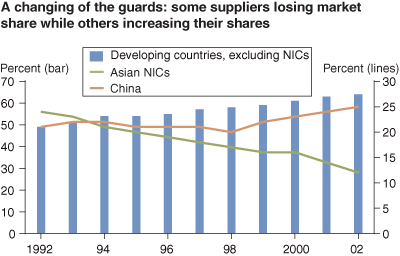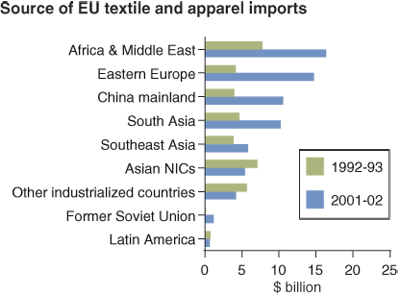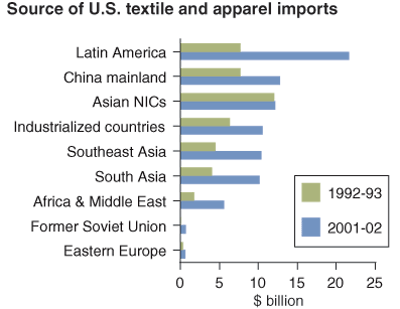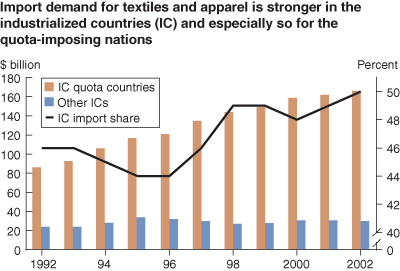The Changing World Network of Trade in Textiles and Apparel
- by Thomas Vollrath, Mark Gehlhar and Stephen MacDonald
- 9/1/2004
The structure of the global textile market is fundamentally changing in response to policy reforms stemming from the 1995 Uruguay Round (UR) of the World Trade Organization. The UR instituted agreements to reduce tariffs on textile and apparel products to levels closer to those found elsewhere in manufacturing. It also established the Agreement on Textiles and Clothing (ATC), which stipulates that all bilateral import quotas, sanctioned under the 1974 Multi-Fiber Arrangement (MFA), will be eliminated by 2005. Full implementation of the UR reforms will bring textiles and apparel into greater conformity with internationally accepted rules of trade. Collectively, these reforms should stimulate growth in textile trade, which already outpaces trade in other sectors of the world economy. For example, trade in textiles and apparel in the last decade nearly doubled to $334 billion. These reforms also promise to significantly alter the location of production and the direction of fiber and textile trade.
The Bilateral Fiber and Textile Trade database, available on the ERS website, enables analysts to examine the evolving structure of trade among partners and across commodities and products in the global market. This database, derived from UN Comtrade data, contains information about commodity and product trade flows among exporting and importing countries/regions between 1992 and 2002.
The global network of trade in textiles and apparel has shifted significantly, with many low-income countries benefiting from higher sales within the past decade. Unlike agricultural production, which depends on the availability of natural resources, the location of textile and, particularly, apparel production is highly mobile and extremely responsive to wage differentials. Textile and apparel production requires substantial labor, is not technologically demanding, and provides employment opportunities for the relatively unskilled laborers who transfer out of subsistence agriculture. It introduces workers to manufacturing and provides them with training opportunities in new and productivity-enhancing activities.
Competition from low-cost suppliers in developing countries has put considerable pressure on established exporters of textiles and apparel, particularly those in the newly industrialized countries (NIC) of Asia (Hong Kong, Macau, Singapore, South Korea, and Taiwan). The Asian-NIC share of the global textile and apparel market halved, falling from 24 to 12 percent between 1992 and 2002. In contrast, the market share of developing-country suppliers, excluding the Asian NICs, increased 15 percentage points to 64 percent during this period. China was especially successful, raising its share of the global market to 25 percent in 2002, up 4 percentage points from 1992. Such competitive pressures from low-cost, developing-country suppliers are likely to accelerate following the elimination of MFA quotas by 2005.
Textile and apparel trade is strongly influenced by established networks and geographical proximity. Together, Africa, the Middle East, and Eastern Europe dominate the EU market because of preferential trading agreements and the economics of geographical location. In contrast, the most important suppliers to the United States are Latin America, China, and the Asian NICs. With improved market access from the ATC, low-income Asian producers are likely to vie more effectively with these traditional suppliers for foreign market shares in the U.S. and EU markets.
The UR reforms are expected to reduce prices for textiles and apparel, increasing worldwide demand for products throughout the fiber-to-clothing supply chain. Demand for textile and apparel imports is already rising rapidly among the industrialized countries (IC). This demand is particularly strong among importers using MFA quotas (Canada, EU, Norway, and the United States). As consumer prices fall due to ATC reforms, imports of clothing, bed linen, carpets, and other products are likely to continue to increase. Envisioned shifts in supply and demand for textile and apparel will enhance labor productivity in the developing countries, leading to income growth and greater global demand for agricultural products, including food and raw fibers, such as cotton.
This article is drawn from:
- Cotton, Wool, and Textile Data - Bilateral Fiber and Textile Trade. (n.d.). U.S. Department of Agriculture, Economic Research Service.






